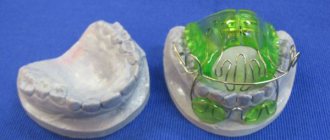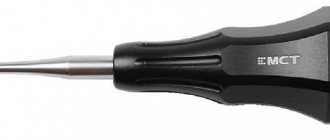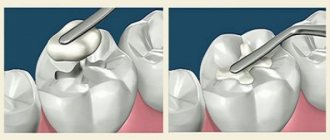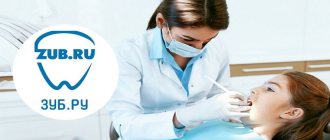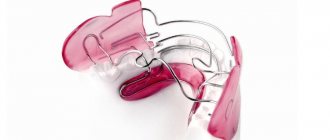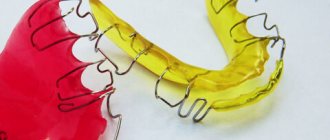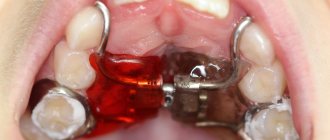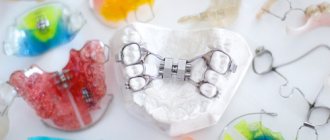A physiologically correct bite is the basis of not only a beautiful smile, but also the quality of the general condition of the entire body. Bite deviations can and should be dealt with regardless of the severity of the defect. Modern orthodontics can cope with any pathologies.
The Herbst appliance is a fixed orthodontic structure designed to correct distal occlusion (when the upper jaw is significantly larger than the lower jaw). Its use can be either an independent method of treatment or an additional means of correction.
What does it consist of?
The device is made of safe medical alloy. The system consists of several elements:
- rings;
- pairs of hinged beams of telescopic design;
- crowns (for lateral dental units);
- curved arcs.
There are several types of Herbst apparatus. More details about them:
- Classic. They are fixed only on artificial metal crowns.
- Products with a plastic base. Designed for patients with complete or partial edentia.
- Optimal. Fixed on orthodontic arches of braces and rings.
What does it represent?
This device is a complex device whose main purpose is to correct severe occlusions . The main elements of the device are made of medical alloy, which is hypoallergenic and durable.
Design
The main difference between the device and other orthodontic devices is its design. This device includes several elements: support crowns, two hinged beams.
The ends of each beam are attached to the supporting crowns using special metal rings. Crowns are placed on the lateral teeth of opposite dentitions, guaranteeing fixation of the jaw in a given position.
The beams have a telescopic design that moves easily when opening the mouth while talking or chewing.
This is ensured by the uneven length of the rod and the beam tube, where the length of the beam is 2 mm longer than the main tube.
To increase the stability of the crowns, they can be equipped with a special curved metal arc, which is simply welded to them.
Depending on the type of installation, the design is divided into several types with minor differences:
- The classic version , strengthened only on artificial metal crowns.
- Fixed on the orthodontic arch of the bracket system and on crowns . Allows you to combine correction of the jaw position with correction of the dentition.
- Installed on a plastic base .
Depending on the initial state of the dentition, the base can be either partial or complete, with detailed restoration. Such a product requires only fixing the base, without separate installation of the device. This option allows you to correct the position of the jaw for people with partial or complete edentia.
Principle of operation
Visual correction of an abnormal position using this device begins from the moment of its installation.
The principle of operation of the device is constant forced tension of the lower jaw , due to which it gradually moves forward.
While wearing the structure, the ligaments and muscles of the jaw are stretched, due to which the correct position of the mandibular joint is formed.
The speed of the device is ensured by the fact that the device is constantly on the teeth, 24 hours a day. When exposed to the Herbst apparatus, after a short period of time one can notice an improvement in the facial profile and its harmony.
A similar corrective effect is obtained when using Sabbah and Forsus springs.
Areas of use
The design feature allows this device to be used only to correct orthodontic problems caused by underdevelopment of the lower jaw or hypergrowth of the upper jaw .
It can also be used to correct orthopedic problems, in conjunction with other corrective devices.
We provide recommendations on how to tighten the Derichsweiler apparatus in the next review.
In this publication we will talk about methods of treating distal occlusion.
Here https://orto-info.ru/sistemyi-vyiravnivaniya-zubov/individualno-izgotovlennyie-apparatyi/ortodonticheskiy-bryuklya-dlja-korrekcii-prikusa.html we will look at the stages of manufacturing the Bruckle apparatus.
Advantages and disadvantages
Now the product is not used in dental practice so often, because a large number of devices with a simpler design have appeared. In addition, they are cheaper in cost. Nevertheless, this device has a lot of advantages. Here are the main ones:
- the ability to correct complex malocclusions;
- fast adaptation period;
- reliable fastening;
- strength;
- hypoallergenic;
- resistance to mechanical damage;
- the ability to predict results;
- therapeutic effects for breathing problems;
- no need to follow a diet.
The use of the design is permitted when enamel mineralization is low. In patients under 17 years of age, the Herbst apparatus can replace surgical correction of the face bow.
Despite many advantages, there are also disadvantages. These include:
- possible negative reaction to a foreign object in the mouth;
- high prices for treatment;
- massiveness;
- low aesthetics;
- difficulties in hygienic care (it is difficult to clean the last crowns);
- risk of injury to the soft tissues of the cheeks.
Patient reviews
Reviews about the Herbst apparatus are mostly positive, so you can safely decide to use this device. This is an excellent opportunity to get a 100% result and correct your bite in a short period of time.
In total, I had to wear the device for 5 months, although it was originally planned to be a little longer. I really liked the installation, I could have walked with it for at least a year. I'm happy with the result! Now I have perfect jaw closure. Teeth before and after the Herbst apparatus are heaven and earth.
Nina
I recently had the Herbst apparatus removed. Overall, I’m happy with everything, but I want to say that it’s better to put rings instead of crowns. If there is such an opportunity, you should definitely use it. The doctor struggled with putting on the crowns for an hour and the same with removing them. The procedure is not pleasant, but it is bearable. After all, the main thing is to solve your dental problem.
Alina
After six months of using the device, it was possible to remove the distal bite, which had previously been impossible to achieve with other orthodontic devices.
But now the bottom row has leaned forward slightly. Now it is returned by a spring to the correct position. The doctor promises that everything will get better. Anton
Treatment
First, the doctor performs a complete sanitation of the patient’s oral cavity. Before installing the device, it is necessary to change old fillings, cure caries and gum disease, and have your teeth professionally cleaned. The support will be attached to the molars, so first of all you need to pay attention to them.
Sometimes surgical intervention is required (for example, frenuloplasty or removal of individual dental units). According to indications, additional measures may be prescribed:
- performing special exercises for the muscles of the mouth and lower jaw;
- consultation with a speech therapist.
The next stage is to take impressions from both jaws to determine the degree of malocclusion. If necessary, removable orthodontic structures are used to align the dental arches and correct the position of the jaws. Then the Herbst apparatus is installed. Algorithm of actions:
- Preparing teeth for a crown. The manipulation is performed under local anesthesia.
- Application of orthophosphoric acids to teeth to increase porosity and better fixation of the composite.
- Drying the enamel.
- Installation of crowns using high-strength composite material.
- Installation of bushings and rods.
- Correction of bushings and rods.
At the same time, you can install other devices designed to correct defects in the dental system.
After completion of therapy, retainers are used to consolidate the results obtained. It is best to give preference to non-removable designs. They provide reliable fixation of the dentition and are invisible when smiling. You will have to wear them for about two years. In rare cases, patients wear retainers throughout their lives.
How to install the device
The first step is preparation for the crown. The fourth tooth is processed at the bottom, and the sixth at the top. The manipulation is carried out under local anesthesia. 1.5 mm is removed from the sides, and 2 mm is removed from the top surface. This is necessary for good fixation of the crown and the absence of discomfort. Orthophosphoric acids are applied to the teeth, which increase porosity, as well as a product that promotes better adhesion.
Next, the crowns themselves are placed, using a high-strength composite or cement. The bushings and power rods are fixed using special clamps and bandage rings. If the device is combined with braces, then the device clings to the arch using centers with gaps. With their help, adhesion to the arc occurs. Then rods are attached to them using mini-screws. Such centers should be located near the supporting teeth.
The last stage is the correction of rods and bushings.
The device is regularly examined by a doctor during treatment. If necessary, you can make the rods shorter. It is important to achieve the optimal size so that they do not injure the oral mucosa and do not slip out of the bushings.
Wearing rules
While wearing the Herbst apparatus, the patient must follow simple rules. Here is their list:
- Monitor the appearance of the product. If any part changes shape, it needs to be replaced. Otherwise, the design loses its functionality, and problems arise when chewing food and opening the mouth. When the rod comes out, there is a risk of injury to the mucous membrane.
- Avoid intense mechanical impact on the device to avoid disturbing the fixation of the crowns and damaging the system.
Retention period
Since the device is aimed at solving a rather complex problem, for the elimination of which the surgical method is most often used, after its removal, retention is mandatory .
During the retention period after treatment with braces, retainers can only be worn for a few hours a day. After the Herbst apparatus, it is recommended to wear a retainer at least 20 hours a day .
Therefore, the most preferable option in this case are permanent type retainers. The average duration of this period is 2 years .
At this time, the ligaments and muscles in the joint are strengthened, its elements are mineralized, and functional adaptation occurs.
Price
The cost of the product depends on the type of design. There are both budget and more expensive options. The minimum price for a template device is 4,500 rubles. Devices with a base and additional elements will cost from 15 to 30 thousand rubles.
The Herbst apparatus is one of the optimal methods for treating complex jaw defects. Under the supervision of an experienced specialist, facial proportions are restored and the correct bite is formed. Reviews from numerous patients prove that good results are achieved quickly.
Price
The cost of the device will depend on the type of design. On average, you can buy it in clinics that provide treatment with this device at a price of 4,500–30,000 rubles .
The minimum price for the service will be when using a template design with 4 metal crowns and power rods. However, the treatment will not include procedures for preparing the dentition and correcting traction.
When installing a device that includes a base, additional springs and other accessories, the cost starts from 15,000 rubles.
Distal bite and methods for correcting it
A distal malocclusion is a malocclusion in which the lower jaw is strongly pushed back relative to the upper jaw. To correct a deep distal skeletal bite, braces alone are not enough, since the position of the lower jaw must be changed.
There are several methods for changing the position of the lower jaw (correcting distal bite):
- surgery to change the size of the jaws;
- use of neuromuscular technologies;
- use of the Herbst apparatus.
The Herbst apparatus may be an alternative to surgical correction of malocclusion in adults, since not all patients are ready for surgery.
Dial-Dent orthodontists, after in-depth diagnostics and carrying out all the necessary calculations, can accurately say whether the Herbst apparatus can be used as an alternative to surgery to correct the bite, and, if possible, carry out effective orthodontic treatment without surgery.
Commentary by the chief physician of Dial-Dent S.V. Tsukora: “Thanks to the fact that the clinic employs very experienced and competent orthodontists who are proficient in various techniques and can work with various equipment, we can offer our patients a choice of treatment methods. In any case, this will be high-quality treatment, but the patient can choose a more comfortable option. The Herbst appliance, as an alternative to surgical correction of the bite, has helped many patients achieve the desired result without stress.”
Operating principle of the Herbst apparatus
A non-removable orthopedic design is a very active device in its effects.
This effect is possible thanks to its operating principle:
- round-the-clock operation of the device on the patient’s jaw;
- the principle of forced constant pressure on the ligaments and muscles of the dentofacial apparatus, allowing the correct position of the lower jaw to be taken and the growth of the upper jaw to be restrained.
Duration of treatment period
Changes in the patient's appearance occur in the first days after the installation of an orthodontic device.
It takes 4-12 months for the functioning of the joints, ligaments and muscles of the dentofacial apparatus to change. The duration of the treatment period depends solely on the age of the patient and the degree of complexity of the pathology.
Design features of the Herbst apparatus
As you know, distal occlusion is one of the most difficult to treat. This is due to deviations in the development of the entire jaw apparatus, and not just a violation of the position of the dental units.
The Herbst apparatus is made from individual casts of the patient’s jaw from titanium alloys and inert steel.
The design contains:
- two beams (telescopic, articulated, not hindering the natural movements of the jaws);
- four support crowns;
- metal rings for attaching beams to crowns.
Aesthetic correction after orthodontic treatment
Since the front teeth were disproportionate in size, at the end of the orthodontic treatment, Dial-Dent restored the front tooth with light-curing material Estelite Sigma Quick (Japan). The dentist who performed the restoration of the front tooth is T.I. Matienko.
Fixation stages
Installation of the device, if it is used at the very beginning of treatment, begins with fixation of buccal tubes on the second molars of the upper jaw.
The maxillary and mandibular arch with braces are installed using standard technology - the adhesive method. The ends of the mandibular arch should be curved after the outermost brackets (installed on the second molars). For reliability, you need to attach the arches to the locks not with elastic, but with wire ligatures.
After fixing the arches, begin installing the EZ module. Using Weingard forceps or another instrument, insert the module clip from the mesial side into the lower tube until it clicks.
Using a special tool in the form of a ruler, measure the distance from the rear edge of the tube to the distal surface of the bracket installed on the canine. If a stopper installed on the arch is used as a support for the mandibular rod, then the distance to it is measured.
When measuring, the lower jaw should be in its natural position (without moving forward). Based on the measurement results, a mandibular rod of suitable length is selected.
The loop of the selected rod is placed on the lower vestibular arch in the intervals between the first premolar and the canine. The point of application of the rod can be changed using a stopper installed on the vestibular arch (the stopper serves to stop the rod and is installed at the point where it is necessary to apply force).
When the patient's mouth is open, the module spring is compressed and a rod is inserted into it. If it is discovered that when the teeth are closed, the rod comes out from the far edge of the spring, you need to use a smaller standard size.
The final manipulation is to compress the rod loop with pliers to prevent it from falling off the arc.
The device is activated (if necessary) by installing a locking ring on the rod in front of the spring (to do this, it must be compressed). The correction step is 2-3 mm.
Watch the video to see how the Forsus device is installed and operates.
